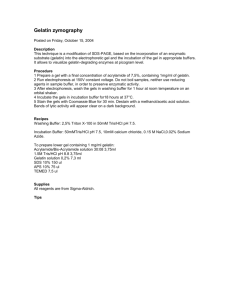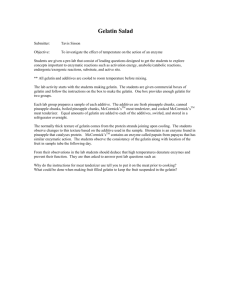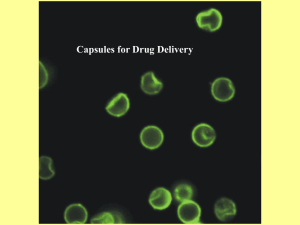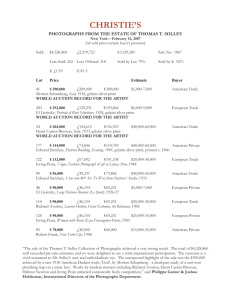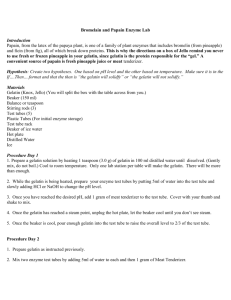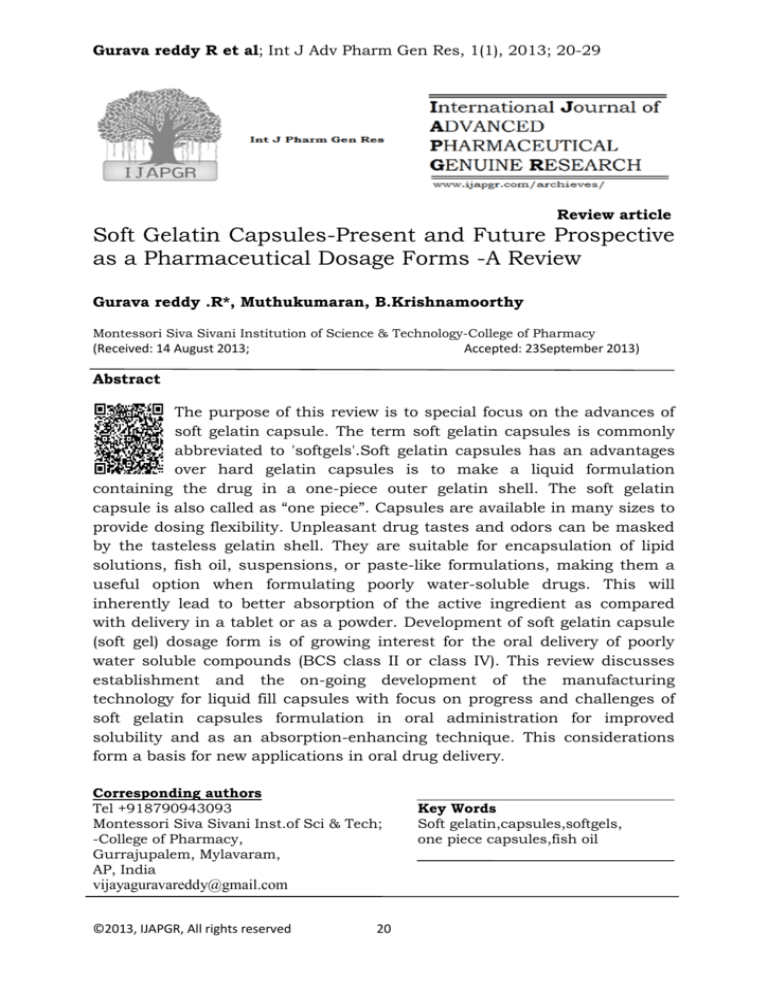
Gurava reddy R et al; Int J Adv Pharm Gen Res, 1(1), 2013; 20-29
Review article
Soft Gelatin Capsules-Present and Future Prospective
as a Pharmaceutical Dosage Forms -A Review
Gurava reddy .R*, Muthukumaran, B.Krishnamoorthy
Montessori Siva Sivani Institution of Science & Technology-College of Pharmacy
(Received: 14 August 2013;
Accepted: 23September 2013)
Abstract
The purpose of this review is to special focus on the advances of
soft gelatin capsule. The term soft gelatin capsules is commonly
abbreviated to 'softgels'.Soft gelatin capsules has an advantages
over hard gelatin capsules is to make a liquid formulation
containing the drug in a one-piece outer gelatin shell. The soft gelatin
capsule is also called as “one piece”. Capsules are available in many sizes to
provide dosing flexibility. Unpleasant drug tastes and odors can be masked
by the tasteless gelatin shell. They are suitable for encapsulation of lipid
solutions, fish oil, suspensions, or paste-like formulations, making them a
useful option when formulating poorly water-soluble drugs. This will
inherently lead to better absorption of the active ingredient as compared
with delivery in a tablet or as a powder. Development of soft gelatin capsule
(soft gel) dosage form is of growing interest for the oral delivery of poorly
water soluble compounds (BCS class II or class IV). This review discusses
establishment and the on-going development of the manufacturing
technology for liquid fill capsules with focus on progress and challenges of
soft gelatin capsules formulation in oral administration for improved
solubility and as an absorption-enhancing technique. This considerations
form a basis for new applications in oral drug delivery.
Corresponding authors
Tel +918790943093
Montessori Siva Sivani Inst.of Sci & Tech;
-College of Pharmacy,
Gurrajupalem, Mylavaram,
AP, India
vijayaguravareddy@gmail.com
©2013, IJAPGR, All rights reserved
20
Key Words
Soft gelatin,capsules,softgels,
one piece capsules,fish oil
Gurava reddy R et al; Int J Adv Pharm Gen Res, 1(1), 2013; 20-29
INTRODUCTION
Overcome
problems
with
manufacture (e.g. oils, low
melting
point
drugs)
as
compressed tablet.
Dose uniformity for low-dose
drugs.
Good product stability.
Many pharmaceutical companies have
the equipment and facilities for the
development
and
production
of
tablets, liquids, and hard shell
capsule products, but they usually
depend upon custom manufacturers
for the development and production of
soft gelatin capsules1. The custom
manufacturers are specialists in the
world, owing primarily to economic,
patent, and technologic factors.
Although few become directly involved
in the manufacture of soft gelatin
capsules, pharmaceutical chemist
must be prepared to investigate this
dosage form and to participate in its
development, either in their own
laboratories or in co operation with
the technological personnel of a
custom manufacturer. Soft gelatin
capsules are one piece, hermetically
sealed,
containing
a
liquid,
suspension, or a semisolid. The
nomenclature for this dosage form has
now been changed to soft gel. They
have long been preferred dosage form
for those, taking health & nutritional
supplements. Soft gelatin capsules
unique advantages over traditional
dosage forms such as tablets, hard
gelatin capsules and liquids.
DISADVANTAGES
Soft gelatin capsules are not
easily prepared except on a
large scale and with specialized
equipment.
They are an expensive dosage
form, when compared with
direct compression tablets.
There is a more intimate
contact between the shell and
its liquid contents than exists
with dry-filled hard gelatin
capsules, which increases the
possibility of interactions.
BASIC COMPONENTS OF
SOFT GELATIN SHELL
CAPSULE SHELL COMPOSITION2, 3
The shell of a soft gelatin capsule is
composed of gelatin, a plasticizer or a
combination of plasticizers and water.
In
addition,
it
may
contain
preservatives,
colouring
and
opacifying agents, flavourings and
sweeteners, possibly sugars to impart
chewable characteristics to the shell,
gastro-resistant substances and in
special cases even active compounds.
ADVANTAGES
Manufacture Liquids can be
encapsulated (non water
soluble).
Small to large sizes possible.
Elegance & Portable odor and
taste masking.
Improved drug absorption.
Easy to swallow.
Avoids dust handling problems
during manufacture and better
operator safety.
©2013, IJAPGR, All rights reserved
Water: The ratio 45% w/w by
weight of water to dry gelatin
can vary depending from 0.71.3 (water) to 1.0 (dry gelatin)
depending on the viscosity of
the gelatin being used.
Plasticizer: Used to make the
soft gel shell elastic & pliable.
21
Gurava reddy R et al; Int J Adv Pharm Gen Res, 1(1), 2013; 20-29
Ration used is between 0.31.8 for soft to hard shell on dry
basis. e.g. Glycerine and
sorbitol.
effectiveness
and
manufacture
efficiency. The liquids are limited to
those that do not have an adverse
effect on gelatin walls. The pH of the
liquid can be between 2.5 and 7.5.
Emulsion cannot be filled because
water will be released that will affect
the shell.
Coloring Agent: Colour used
in shell has to be darker than
color
of
encapsulating
material. Color may be natural
or synthetic.
Vehicles used in soft gelatin capsules
Water immiscible, volatile or more
likely
volatile
liquids
such
as
vegetable oils, mineral oils, mediumchain triglycerides and acetylated
glycosides.
Opacifiers: Usually used is
titanium dioxide, may be
added to produce an opaque
shell, when the fill formulation
is a suspension or to prevent
photo degradation of light
sensitive
fill
ingredients.
Concentration of opacifiers
may be up to 0.5%.
Water miscible, non-volatile liquids
such as low molecular weight PEG
have come into use more recently
because of their ability to mix with
water
readily
and
accelerate
dissolution of dissolved or suspended
drugs. All liquids used for filling must
flow by gravity at a temperature of 35
° C or less.
The sealing temperature of gelatin
films is 37- 40 ° C.
Chelating agents:
Iron is
always present in raw gelatin &
should not contain iron more
than 15 ppm. Additionally
chelating agent may be used
for preventing the reaction of
iron with materials or colours.
TYPES OF FILL MATRIXES 6
Gelatin: There are two main
types of gelatin: Type A:
produced by acid hydrolysis of
animal
skins.
Type
B:
produced by basic hydrolysis
of bovine bones. A soluble
biological
fluid
at
body
temperature. It is a good filmforming material. Solutions of
high concentration, 40% w/v,
are mobile at 50°C.
Lipophillic liquids / oils: e.g.
Soya bean oil.
Hydrophilic
liquids:
PEG400.
Self-emulsifying oils (oil +
non ionic surfactant).
Micro emulsion and nanoemulsion
systems
and
suspension.
FORMULATION FOR SOFT
GELATIN CAPSULES 4,5
It involves liquid, rather than powder
technology. Materials are generally
formulated to produce the smallest
possible capsule consistent with
maximum
stability,
therapeutic
©2013, IJAPGR, All rights reserved
Fig
1.
Shows
flow
chart
of
manufacturing of soft gelation capsules
22
Gurava reddy R et al; Int J Adv Pharm Gen Res, 1(1), 2013; 20-29
MANUFACTURING PROCESS OF
SOFT GELATIN CAPSULE
the mixture while a very high torque
tribune mixer stirs it under vacuum.
At this stage, approximately 20% of
gelatin mixture consists of water.
Manufacturing process of soft gelatin
process divided into some steps, there
are:
1. Gelatin Preparation
2. Material (Fill) Preparation
3. Encapsulation
4. Drying
5. Inspection
6. Polishing
7. Packaging
1. Gelatin Preparation 7
Raw granular gelatin is mixed with
glycerine and water. Glycerine acts as
a plasticizer in the gelatin compound.
Other plasticizers can also be used
either alone or in combination with
glycerine, such as sorbitol. Colouring
agent can also be added at this stage.
The proportions of each ingredient
involved in the mixture should be
considered carefully because the shell
material needs to be adapted to
formulation and/or environmental
requirements. For instance the gelatin
recipe may need to be adjusted to
account for acidity, water content of
the fill material or high humidity
environmental conditions.
Fig 3. Heated tank
This process takes around 3 hours
until the gelatin turns into a molten
liquid mass. As soon as the liquid
gelatin
mass
is
ready
for
encapsulation
process,
it
is
transferred to ground heated tanks
which are wheeled into the clean room
where
the
main
encapsulation
machine is. Because the only way to
keep the gelatin mixture as liquid is to
keep it warm otherwise it will solidify
like jelly. It is really important to plan
and schedule the gelatin production
in terms of time and quantity. At
least, it requires 2 shift operation.
2. Material (Fill) Preparation
5
A homogeneous fill material plays a
vital role to ensure the uniformity of
each
soft
gel
dose.
Various
equipments should be available such
as processing tanks, high-shear
mixer, homogenizer and variety of
mills is used.
There are two types of fill
materials: oil mixtures or pastes.
Fig 2. Gelatin melting tank
After the ingredients are combined,
the mixture is placed into a reactor
called as gelatin melter. The reactor
surrounded by a thermal jacket heats
©2013, IJAPGR, All rights reserved
Oil mixtures are very easy to
formulate. The oils are mixed,
deposited into a ground material tank
and moved into the hopper of the
23
Gurava reddy R et al; Int J Adv Pharm Gen Res, 1(1), 2013; 20-29
encapsulation machine (i.e., vitamin
E, fish oils).
shape and size of soft gels and cut the
Soft gel shell from the ribbons as they
turn around.
Pastes are oils or polyethylene glycols
added with powders. Two important
factors that affect the homogeneity
and flow of the paste should be
considered:
1. Particular size of powder in order to
allow homogeneous mixture, powder
particles must not
be thicker than
80 mesh.
2. Viscosity of the mixture. If the
mixture is not thin enough, it will not
flow correctly through the machine
injections.
Fig 4. Rotary die filling machine
Natural
or
artificial
flavours,
sweeteners
and
fragrances
are
commonly used to make chewable soft
gels or to mask the unpleasant taste
and odour of the fill material such as
fish oils. These can go into fill or
gelatin material.
3. Encapsulation
8
Encapsulation is the manufacturing
process that brings the gelatin shell
and the fill material together to form
Soft gel capsules. It takes place in a
closed environment called clean room
where the relative humidity is around
20%. The gelatin shell and fill material
are brought together simultaneously
in the encapsulation machine.
Fig 5. Automatic filling machine.
Simultaneously, a sensitive and high
accuracy, positive displacement pump
delivers the fill materials into a heated
wedge which sits between rotary dies.
This wedge injects the fill material
into the die cavities between ribbons
just right before the die rolls cut the
ribbons and seal the two halves
together. The cool, dry air congeals
the gelatin as the drum rotates so that
a tacky, elastic band rolls off of the
other end. This thin band is then
automatically formed into capsules;
filled with medicine, vitamins or other
products sealed and dropped into a
tray. If the air blowing against the
drum has too low a temperature, the
gelatin will set too rapidly and
humidity are too high, or the air
The process is basically performed as
described; a pump delivers the warm
gelatin over two chilled drums which
are located at both opposite sides of
the machine, through a spreader box
that sits over each drum. The
revolving stainless steel drum is about
24” in diameter and exposed to 400
CFM of 57-59°F air at 20% RH. The
warm liquid gelatin flows over the
drums and this transforms the liquid
gelatin into two solid ribbons of gel.
The left and right ribbons pass over
rollers which feed them through two
die rolls. These die rolls determine the
©2013, IJAPGR, All rights reserved
24
Gurava reddy R et al; Int J Adv Pharm Gen Res, 1(1), 2013; 20-29
become brittle which can cause the
manufacturing process to grind to a
halt. Too high of an air velocity will
disturb the consistent thickness of the
gelatin ribbon being formed. If the air
temperature velocity is too low, the
gelatin will not solidify into a ribbon.
Thus, the need for constant control of
the air being introduced to the drum
is critical in the process. From the
capsulating machines, the soft &
moist capsules are transferred to
drying drums or chambers for rapid
drying. The extent of moisture to be
removed during drying depends upon
the size of the capsule, the number of
capsules, and the period of time over
which this moisture can be removed.
Performed by a tumble dryer consists
of sections. This equipment tumbles
the soft gels around 30 to 40 minutes
and
removes
approximately
25
percent of the water content in the
soft gel capsules.
Soft gel capsules are spread on
stackable trays and transferred to the
drying room or tunnel where high air
flow exists and they stay around 24 to
48 hours or until the soft gels become
hard enough. This process is called
natural manual drying. By using a
fully automatic Soft gel drying
machine, this long drying process
time can be reduced to a few hours
which enables you to save time and
money.
4. Drying
Drying process purpose is to decrease
the moister content to create a hard
and durable finished soft gel capsules
ready for packaging. After the soft gels
are formed through the die rolls, they
contain around 20 percent water. This
amount of water content is needed to
keep the gel flexible enough to form
the capsules.
Drying
process
requires
an
environment
with
low
relative
humidity in the air but not hot air.
This process divided into two stages:
Fig 7. Soft gelatin capsule drying
machine
Typically the environment to be
maintained for effective and rapid
drying corresponds to a dew point of
25° F or an absolute humidity level of
20 grains per pound of air. The
following
are
typical
design
conditions: Temperature Humidity
78°F 15% RH 68°F 20% RH In order
to
achieve
the
controlled
air
requirement listed above, refrigeration
equipment
alone
becomes
uneconomical,
impractical
and
cumbersome to design, operate and
maintain.
On
the
other
hand
Fig 6. Fluid bed tumble drier for soft
gel
First stage
©2013, IJAPGR, All rights reserved
Second stage
25
Gurava reddy R et al; Int J Adv Pharm Gen Res, 1(1), 2013; 20-29
desiccant
type
dehumidifiers
combined with refrigeration can offer
a simple and economical solution to
controlling both temperature and
humidity levels as low as necessary
Dry-Air desiccant dehumidifiers have
been utilized in many capsulating and
soft gel manufacturing applications all
over the world resulting in millions of
dollars saved annually.
Soft gel shell moisture level and
soft gel hardness at the end of
the drying stage.
Finished product testing
Capsule appearance.
Active ingredient assay
related substances assay.
Fill weight.
Content uniformity.
Microbiological testing.
5. Inspection& In Process Control
for Finished Product 9
6. Polishing
The final step before packaging is to
clean and polish the Soft gel capsules
to remove any mineral oil or glycerine
that the capsules may have on their
exterior skin. Tumbling is the most
used production method to clean the
Soft gel capsules among others such
as washing with solvent.
Due to air pockets in the gelatin and
fill material and district production
tolerances, the Soft gel capsules may
vary in size and need to be inspected
visually. Any misshaped, damaged
and/or not fully filled capsules are
removed manually by using an
inspection table. Manual inspection
process can be preferred if you have
small batch size production but if you
intend to manufacture soft gel
capsules in mass quantities. Manual
inspection will be time consuming
process which leads to accuracy
problems. In order to reduce process
time and increase the accuracy, fully
automatic soft gel sorting machine
equipped with electronic sensors can
be used to sort and remove the
damaged, misshaped, broken etc.
gelatin capsules. Two to three percent
is an acceptable reject rate.
7. Packaging
There is no difference between
packaging soft gels and traditional
tablets or hard capsules. Any finished
Soft gel product should be stored in
an environment with temperature
around 20-24 °C and relative
humidity 35%.
In-process testing
During the encapsulation process the
four most important tests are:
Fig 8 . Different shapes of soft
gelatin capsule
The gel ribbon thickness.
Soft gel seal thickness at the
time of encapsulation.
Fill matrix weight & capsule
shell weight.
©2013, IJAPGR, All rights reserved
&
Formulation factors affecting drug
availability from capsules
26
Gurava reddy R et al; Int J Adv Pharm Gen Res, 1(1), 2013; 20-29
The overall dissolution rate of a drug
from capsules may be regarded as a
function of several variables:
This test applies to all types of
capsules and it is to be done on 20
capsules.
Method
The dissolution rate of the
shell.
The rate of penetration of the
dissolution medium into the
powder.
The rate at which the powder
mass de aggregates.
The amount and nature of
adjuvant such as diluents,
surfactant (infused).
Drug particle size.
The
composition
and
characteristics of the capsule
shell.
Weigh an intact capsule.
Open the capsule without
losing any part of the shell and
remove
the
contents
as
completely as possible.
Weigh the shell.
The weight of the contents is
the difference between the
weighing.
Repeat the procedure with a
further 19 capsules Selected at
random.
Determine the average weight.
Limit
EVALUATION OF
COMMERCIAL CAPSULES 10
Not more than two of the individual
weights deviate from the average
weight by more than the percentage
deviation shown in the table below,
and none deviates by more than twice
that percentage.
Content uniformity.
Weight Uniformity.
Disintegration and
Dissolution.
Disintegration
The disintegration test determines
whether
tablets
or
capsules
disintegrate with in a prescribed time
when placed in a liquid medium
under the prescribed experimental
conditions.
Content uniformity
30 capsules are selected and
10 of these are assayed
individually.
At least 9 of these contain 85–
115% of drug and none
contain below 75–125% of
drug.
If 1to 3of them fall outside of
85–115% limits, the remaining
20 capsules are individually
assayed and the requirements
are met if no few than 27
Contain 85– 115% of drug and
none contain less than 75–
125% of drug.
Method
According to the B.P. and applies to
hard and soft capsules.
Weight Uniformity
©2013, IJAPGR, All rights reserved
27
Introduce one capsule into
each tube and suspend the
apparatus
in
a
beaker
containing 600 ml water at 37
°C. If hard capsules float on the
surface of the water, the discs
may be added.
Operate the apparatus for 30
minutes; remove the assembly
from the liquid.
The capsules pass the test if ,
Gurava reddy R et al; Int J Adv Pharm Gen Res, 1(1), 2013; 20-29
CONCLUSION
No residue remains on
the screen of the apparatus
or,
If a residue remains, it
consists of fragments of shell
or,
If a soft mass with no
palpable core.
If the disc is used, any
residue remaining on its lower
surface
should
only
consist of fragments of shell.
Interesting advances have recently
been made in the area of developing
liquid and semi-solid formulation in a
soft gelatin capsule to address
particular bio performance issues,
namely an increase of bioavailability
and decrease of plasma variability by
improving solubility and absorptionenhancing techniques. Although the
soft
gel
capsules
have
many
advantages, they also face stability
problem, mainly for the soft capsules
stored for longer than six months.
After this time, their soluble products
decreased and the remnants cannot
be re-dissolved and/or reabsorbed
into the gastrointestinal tract. These
problems could be investigated as a
research subject.
Dissolution
The dissolution test is carried
out using the dissolution
apparatus official in both the
U.S.P. and N.F.
The capsule is placed in a
basket
formed
from
40meshstainless steel fabric.
A stirrer shaft is attached to
the basket, and the basket is
immersed in the dissolution
medium and caused to rotate
at a specified speed.
The dissolution medium is held
in a covered1000 ml glass
vessel and maintained at
37°C±0.5°C
by means of a
suitable constant- temperature
water bath.
The stirrer speed and type of
dissolution
medium
are
specified in the individual
monograph.
References
1. Lachman & Lieberman. The theory
and practice of Pharmacy. New
Delhi: CBS publisher; 817- 823.
2. Jones RT. Gelatin: manufacture
and Physico-chemical properties.
In: Podczeck F, Jones B E (eds)
Pharmaceutical capsules. London:
Pharmaceutical Press; 2004; 23-60
APPLICATIONS
3. Hom FS, Veresh SA, Ebert WR.
Soft gelatin capsules II: Oxygen
permeability study of capsule
shells. Journal of pharmaceutical
sciences 1975; 64(5): 851-7.
As an oral dosage form of
ethical or proprietary products
for human or veterinary use.
As a suppository dosage form
for rectal use, or for vaginal
use.
As a specialty package in the
tube form, for human and
veterinary
single
dose
application
of
topical,
ophthalmic,
and
optic
preparations,
and
rectal
ointments.
©2013, IJAPGR, All rights reserved
4. Brox
W.
Pharmaceutical
compositions. EP.
1983; 0121321.
5. Brox W, Zande H, Meinzer A. Soft
gelatin capsule manufacture. EP
1993; 0 649- 651.
28
Gurava reddy R et al; Int J Adv Pharm Gen Res, 1(1), 2013; 20-29
6. Aulton’s
Pharmaceutics,
The
design
and
manufacture
of
medicines.
3rd
ed.
Churchill
Livingstone; 2007; 538.
9. Ferdinando
JC.
Formulation
solutions
–
Softgels.
Pharmaceutical
Manufacturing
and Packaging Source Spring
Issue, 2000; 69-73.
7. Aulton’s
Pharmaceutics.
The
design
and
manufacture
of
rd
medicines.
3
ed.
Churchill
Livingstone; 2007; 517.
10. Ansel’s. Pharmaceutical Dosage
Forms and Drug Delivery Systems.
8th ed. New Delhi: B.I.Publications;
2006; 218-219.
8. Brox, W. Soft gelatin capsules and
methods for their production. US
Patent, 1988; 4 744 988.
©2013, IJAPGR, All rights reserved
29

